Chapter 12: Bank reconciliations
Chapter learning objectives
Upon completion of this chapter you will be able to:
- describe the purpose of bank reconciliations
- identify the main differences between the cash book and the bank statement
- identify the bank balance to be reported in the final accounts
- correct cash book errors or omissions
- prepare bank reconciliation statements
- derive bank statement and cash book balances from given information.
1 The bank reconciliation
The objective of a bank reconciliation is to reconcile the difference between:
- the cash book balance, i.e. the business’ record of their bank account, and
- the bank statement balance, i.e. the bank’s records of the bank account.
Note that debits and credits are reversed in bank statementsbecause the bank will be recording the transaction from its point ofview, in accordance with the business entity concept.

 Reasons to prepare a bank reconciliation statement
Reasons to prepare a bank reconciliation statement
Nature and purpose of a bank reconciliation statement.
The cash book records all transactions with the bank. The bankstatement records all the bank’s transactions with the business.
The contents of the cash book should be exactly the same as therecord provided by the bank in the form of a bank statement, andtherefore our records should correspond with the bank statement.
This is in fact so, but with three important provisos:
(1) The ledger account maintained bythe bank is the opposite way round to the cash book. This is because thebank records the balance in favour of an individual as a creditbalance, i.e. a liability of the bank to the individual. From theindividual’s point of view it is, of course, an asset, i.e. a debitbalance in his cash book.
(2) Timing differences must inevitablyoccur. A cheque payment is recorded in the cash book when the cheque isdespatched. The bank only records such a cheque when it is paid by thebank, which may be several days later.
(3) Items such as interest may appearon the bank statement but are not recorded in the cash book as thecashier is unaware that they have arisen.
The existence of the bank statement provides an important check onthe most vulnerable of a company’s assets – cash. However, thedifferences referred to above make it essential to reconcile the balanceon the ledger account with that of the bank statement.
The reconciliation is carried out frequently, usually at monthly intervals.

2 Differences between the bank statement and the cash book
When attempting to reconcile the cash book with the bankstatement, there are three differences between the cash book and bankstatement:
- unrecorded items
- timing differences
- errors

 Cash book adjustments
Cash book adjustments
Unrecorded items
These are items which arise in the bank statements before theyare recorded in the cash book. Such ‘unrecorded items’ may include:
- interest
- bank charges
- dishonoured cheques.
They are not recorded in the cash book simply because the businessdoes not know that these items have arisen until they see the bankstatement.
The cash book must be adjusted to reflect these items.


 Test your understanding 1
Test your understanding 1
On which side of the cash book should the following unrecorded items be posted?
- bank charges
- direct debits/standing orders
- direct credits
- dishonoured cheques
- bank interest.


 Bank reconciliation adjustments
Bank reconciliation adjustments
Timing differences
These items have been recorded in the cash book, but due to thebank clearing process have not yet been recorded in the bank statement:
- Outstanding/unpresented cheques (cheques sent to suppliers but not yet cleared by the bank).
- Outstanding/uncleared lodgements (cheques received by the business but not yet cleared by the bank).
The bank statement balance needs to be adjusted for these items:


Errors in the cash book
The business may make a mistake in their cash book. The cash book balance will need to be adjusted for these items.
Errors in the bank statement
The bank may make a mistake, e.g. record a transaction relatingto a different person within our business’ bank statement. The bankstatement balance will need to be adjusted for these items.

 Outstanding payments and receipts
Outstanding payments and receipts
Outstanding or unpresented cheques
Suppose a cheque relating to a payment to a supplier of Poorboy iswritten, signed and posted on 29 March. It is also entered in the cashbook on the same day. By the time the supplier has received the chequeand paid it into his bank account, and by the time his bank has gonethrough the clearing system, the cheque does not appear on Poorboy’sstatement until, say, 6 April. Poorboy would regard the payment as beingmade on 29 March and its cash book balance as reflecting the trueposition at that date.
Outstanding deposits
In a similar way, a trader may receive cheques by post on 31March, enter them in the cash book and pay them into the bank on thesame day. Nevertheless, the cheques may not appear on the bank statementuntil 2 April. Again the cash book would be regarded as showing thetrue position. Outstanding deposits are also known as outstandinglodgements.

3 Proforma bank reconciliation
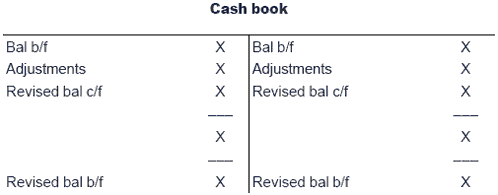
Bank reconciliation statement as at …..

- Beware of overdrawn balances on the bank statement.
- Beware of debits/credits to bank statements.
- Beware of aggregation of deposits in a bank statement.
- Note that the bank balance on the statement of financial position is always the balance per the revised cash book.

 Test your understanding 2
Test your understanding 2
In preparing a company’s bank reconciliation statement, theaccountant finds that the following items are causing a differencebetween the cash book balance and bank statement balance:
(1) Direct debit $530.
(2) Lodgements not credited $1,200.
(3) Cheque paid in by the company and dishonoured $234.
(4) Outstanding cheques $677.
(5) Bank charges $100.
(6) Error by bank $2,399 (cheque incorrectly credited to the account).
Which of these items will require an entry in the cash book?
A 3, 4 and 6
B 1, 3 and 5
C 1, 2 and 4
D 2, 5 and 6


 Test your understanding 3
Test your understanding 3
The following information has been extracted from the records of N Patel:
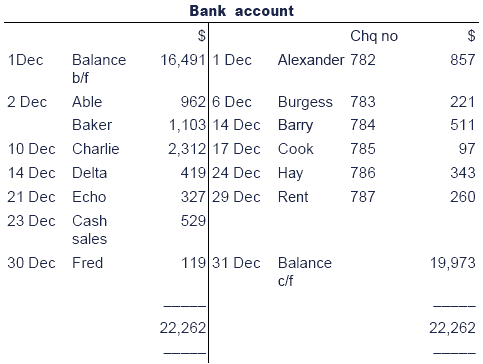
High Street Bank
Bank Statement – N. Patel
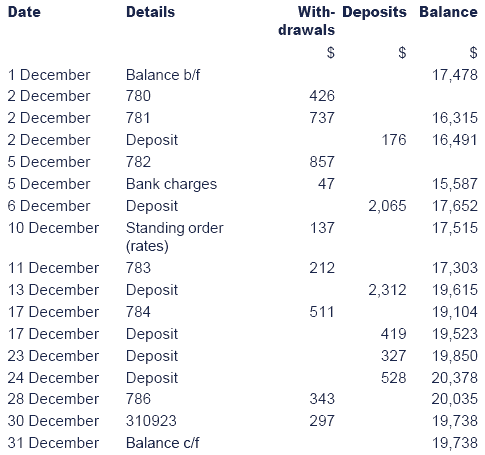
(a) Prepare a bank reconciliation statement at 1 December.
(b) Update the cash book for December.
(c) Prepare a bank reconciliation statement at 31 December.


 Test your understanding 4
Test your understanding 4
The following is a summary of Ami’s cash book as presented to you for the month of December 20X6:

All receipts are banked and payments made by cheque.
On investigation you discover:
(1) Bank charges of $136 entered on the bank statement had not been entered in the cash book.
(2) Cheques drawn amounting to $267 had not been presented to the bank for payment.
(3) A cheque for $22 had been entered as a receipt in the cash book instead of as a payment;
(4) A cheque drawn for $6 had been incorrectly entered in the cash book as $66.
What balance is shown on the bank statement at 31 December 20X6?
A $913
B $941 overdraft
C $941
D $407 overdraft

Chapter summary
Test your understanding answers

 Test your understanding 1
Test your understanding 1



 Test your understanding 2
Test your understanding 2
The correct answer is B


 Test your understanding 3
Test your understanding 3

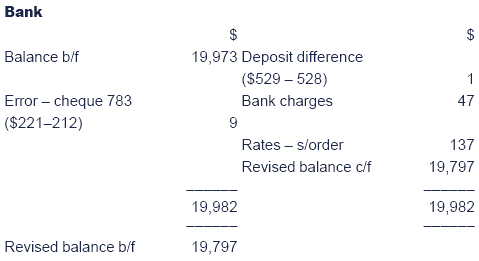



 Test your understanding 4
Test your understanding 4
The correct answer is D
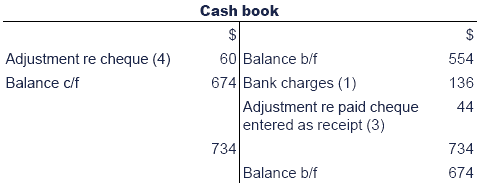


|
Created at 5/24/2012 3:35 PM by System Account
(GMT) Greenwich Mean Time : Dublin, Edinburgh, Lisbon, London
|
Last modified at 5/25/2012 12:53 PM by System Account
(GMT) Greenwich Mean Time : Dublin, Edinburgh, Lisbon, London
|
|
|
|
 |
Rating
:
|
 Ratings & Comments
(Click the stars to rate the page) Ratings & Comments
(Click the stars to rate the page)
|
 |
Tags:
|
|
|
|
|